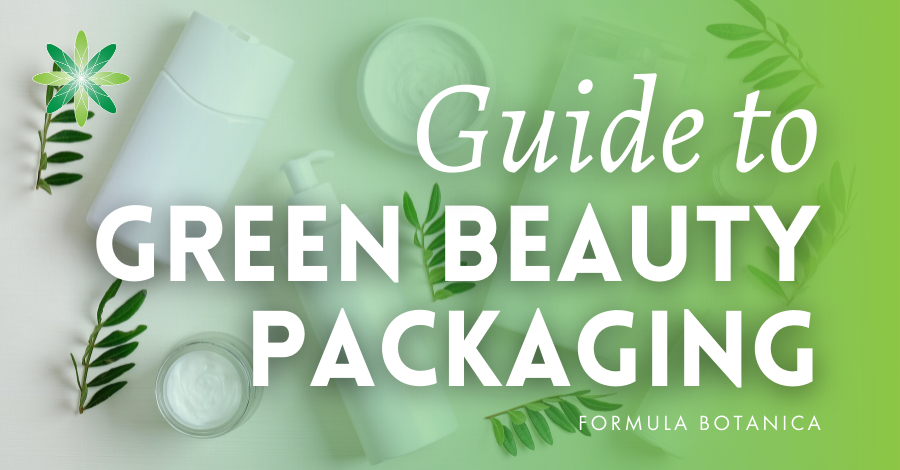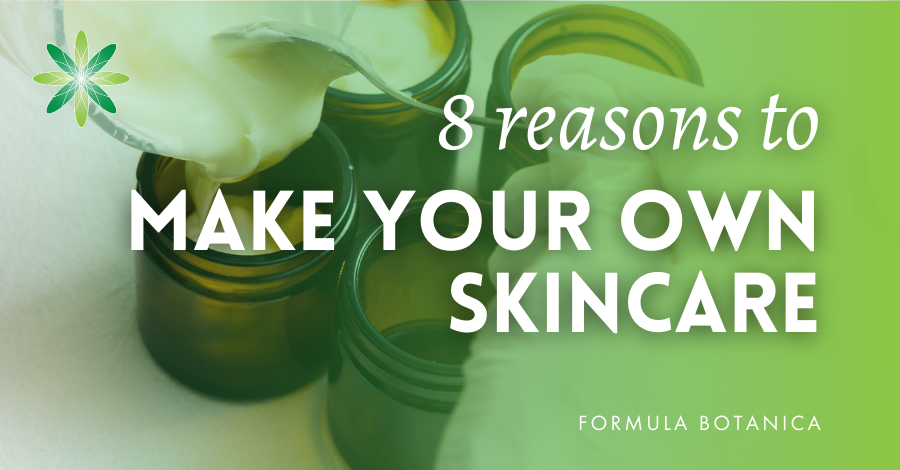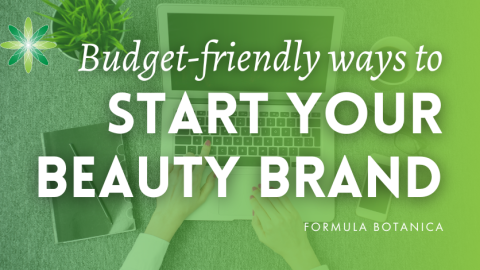Packaging your beauty products is one of the most complex and frustrating aspects of being an indie beauty entrepreneur and even more so if you’re keen to use green beauty packaging. It seems the most fun and glamorous part of building a beauty brand and the icing on the cake after months or years of developing your product range.
But, if there is one topic that dominates the Formula Botanica online community of students, graduates and indie beauty founders, it has to be packaging – or to be specific, the search for the ideal sustainable, recyclable or even biodegradable packaging.
Whatever stage you are at in your beautypreneur journey, this post is essential reading. We invited packaging consultant and product creation expert Rebecca McKnight to take us through the beauty product packaging process and provide checklists on what to think about en route from concept to designed packaging. A product development consultant for large retail brands and an ex-buyer, Rebecca is also a Formula Botanica graduate with her own aromatherapy and wellness brand.
First, let’s start with the basics about why we have packaging at all.
What does packaging need to do?
Well, quite a lot actually.
- It needs to be able to hold the cosmetic formulation which can include liquids, oily products, acids, concentrated fragrances and alcohol…
- and it must do so without staining, leaking, breaking, corroding or leaching into your formulation.
- It needs to be hygienic for use and storage.
- It needs to protect from light, air, moisture, heat and contamination and help maintain the shelf life of your formulation.
- It needs to be practical for use and suitable for its purpose, including safe and convenient for use in areas such as showers or bathrooms.
- By law, it needs to hold quite a lot of information.
While intended as a reminder, this list shows just how complex the primary purpose of cosmetic packaging is even before we factor in the desires you and your customers may have. So, keep these practical reasons in mind as we move on to the options you’ll need to consider in packaging your beauty products.
The @FormulaBotanica guide to green beauty packaging by @productcreationguru takes you from overwhelm to action to get your indie beauty brand retail ready. #indiebeauty #cosmeticspackaging #sustainablepackaging Share on XGreen beauty packaging: the process
When to start thinking about packaging
It is never too soon to think about how to package your products. It is as important as what is in your formulation. Your product is the whole thing. It reflects your brand values. It dictates how your customer will use your formulations and who will be attracted to your products.
The consistency of your product will determine how you package your products – and vice versa. If you are set on a certain type of packaging you need to formulate products that suit it.
If your brand’s top value is zero waste, you may need to focus for example on lotion bars and solid shampoo rather than their regular liquid versions. You certainly don’t want to be deciding this once you have already created a different type of formulation.
Your choice of packaging also has a role to play in determining the level of preservative you need in your formulation. It will shape how and where your customers can use your product. It will form part of the cost of your product too.
So, as you can see, even from these few examples, you need to think about packaging and formulation at the same time and certainly right at the start of beauty business journey.
A note about branding
Before you dive into your wishlist of green credentials for your packaging, it’s worth stating that you will probably need to have started a branding process. Branding and packaging dovetail just like formulation and packaging do. Because if you don’t know who you want to help or what their values are, you cannot possibly give them products to help resolve their beauty needs, let alone in appealing, usable packaging.
Only after starting your branding process and outlining your ideal customer’s profile, should you start listing the essential requirements for your packaging, and the type of materials, colours and shapes you might choose.
You might like to listen to these Formula Botanica Green Beauty Conversations podcasts as background on branding.
Episode 15: Top 10 tips for branding indie beauty businesses
Episode 16: Beginner’s guide to branding a beauty business
Episode 17: Working with a designer on branding your beauty business
Your green beauty packaging wishlist
Now, it’s time to ask yourself how long a list of essential requirements you have for your packaging. This is where the fun begins because once you factor in issues such as your budget, minimum order quantities and the logistics of delivery, you will likely need to compromise and reduce your green packaging wishlist considerably.
But to start with, ask yourself if your packaging needs to do any of the following?
- include zero waste, vegan, compostable, or recyclable requirements.
- hold liquids and/or essential oils.
- be shower and bathroom safe.
- have an airless pump to protect it from contamination from air, water or wet hands.
- be made of sustainable materials.
- be made of plant sources that aren’t grown replacing vital food crops.
- be manufactured by entities paying a fair pay.
- leave a zero carbon footprint.
- have design/brand requirements that need specific materials
- …and have a whole lot of similar requirements?
This list doesn’t even touch on your desire for stunning packaging in sleek black or muted pastels, and your need to have cost-effective, locally-made containers in very low minimum order quantities (MOQs).
We all want the perfect solution, but initially we may need to compromise. It is essential you start to prioritise your list of values.
Packaging issues indie brands face
Sustainability
As we discussed at the start, cosmetics packaging needs to be able to do a lot. In addition, you may wish to add your own sustainability values. This is where you get to choose what is non-negotiable for you. Your non-negotiable requirements might include:
- 100% recyclable
- Made from recycled material
- Made from renewable plant material
- Home compostable
- A low carbon footprint
The truth is, although we would all love our packaging to be all of these things, you need to choose. Sometimes, it is only physically possible to have one or the other. Be prepared for trade-offs.
For example, compostable materials are generally not recyclable for the very reason they are designed to break down quickly. They would be unstable if used again.
If you choose compostable materials, ask if they can be home composted and relatively quickly. Or do they need to be broken down in industrial composters, which can be resource heavy and therefore create other environmental impacts. Can consumers in towns and cities compost the packaging easily?
Packaging made from renewable plant sources like bamboo and sugar cane is likely to be sourced from a different continent to where you live and so may have a higher carbon footprint in terms of transport. Are the employees processing bamboo or sugar cane crops paid a fair wage? Some of these crops may be harvested by child labour. How will you know this?
You need to prioritise your wishlist of sustainable packaging requirements and do the research so you can make informed choices.
Minimum Order Quantities
Because of the way that most packaging is produced, there are often very high minimum order quantities (known as MOQs), especially if you want something exclusive to you. This can be quite disappointing for small brands starting out with a big vision.
Do not despair; it is still possible to purchase a small quantity of packaging to start with. You may need to be more flexible in your choices and find creative ways to make your brand unique. You can also evolve as you grow and afford more options once you have sales coming in and demonstrated proof of concept of your products.
Don’t burn all your cashflow or savings on bespoke packaging at the outset only to find that your customers are asking for a more useful, appropriate sizes and styles for their needs.
Price of packaging
The problem with lower quantities is that they cost more. This makes it harder for a small brand to compete on price with the big players.
My advice? Don’t try to compete with the big boys. Be unique. Offer great customer service, a personal touch, an engaging brand story, and something quirky and with flexibility. Sell your product in places where you can connect directly with your customers and in places where they are looking for honest authentic brands created by real individuals who share their values. Don’t try to be the cheapest. Try to be the best.
What is the most eco-friendly packaging?
Here is a summary of some of the most common green beauty packaging types with their pros and cons. It gives you a quick overview of your options. Clearly, you will need to do more detailed research and especially in regard to your local or country options for things like recycling and delivery.
| Material | How recyclable? | Energy to recycle | Biodegrade in landfill | Sustainability check |
|---|---|---|---|---|
| Glass: clear, brown, green | Widely recycled. | 70% of new | 1 million years | High transport carbon footprint as heavy. 1200C manufacturing temperature. Limestone mining can be damaging to environment. |
| Glass: sprayed, opaque & black glass | Rarely recycled | N/A | 1 million years | As above |
| Aluminium | Widely recycled | 5% of new | 250 years | Open pit mining can cause erosion & destroy habitats. Water hungry. |
| Plastics | Certain plastics widely recycled. Mixed materials, black plastic & some plastic materials not recyclable | Certain plastics: 10% of new. | 450 years | Non-renewable fossil fuel. Micro plastic marine life pollution. Total energy used is less than glass or aluminium though. |
| Bio-plastic | Biodegradable & compostable plastic cannot be recycled | N/A | Varies - can be as plastic | Usually requires industrial composting at high temperatures. May use food crop land. May not be kerbside collected or recyclable so often ends up in landfill. |
| Cardboard | Widely recycled | 60% of new | 2 months | Deforestation (but new trees also grown). Water hungry. Bleaching. |
Concluding tips
Take one step at a time. Each step you take is a move forward. As you grow your brand, more choices of green beauty packaging will become available and the more influence you will have over what is possible for your brand.
Work together with other indie beauty brands to press packaging manufacturers to accommodate the needs of the indie sector. Be creative in finding ways to improve your brand’s green packaging credentials and to deliver on promises. Start with your top three, non-negotiable priorities and stick to them. Don’t embrace more unless you can afford them and can sustain them.
Here is a final checklist of simple tips to get you started rather than leave you feeling overwhelmed by the whole green and sustainable packaging journey:
For lower quantities
- Buy stock container shapes.
- Label rather than print bottles and jars.
- Digitally print your labels and boxes – there are lots of digital label printers online.
For suitability
- Dark glass protects essential oils from light and leaching.
- Avoid glass for shower products for safety – aluminium may be a good alternative.
- Consider how your customer will use it and try it out yourself – is it easy or irritating to use? Can you avoid contamination from shower water or customers fingers, for example?
For more sustainable options
- Create solid formulations that need the least packaging.
- Create dry formulations that your clients can mix with their own liquids. These have lower requirements for packaging.
- Consider that easy kerbside recyclability might be more eco-friendly than plant-based bio plastics.
- Lastly, never use black coloured plastic. It cannot be recycled.
Rebecca’s top 3 priorities:
- Identify your non-negotiable values.
- It is never too early to start thinking about your packaging.
- Collaborate with other brands to create a louder voice for change.
Meet our guest author

Find Rebecca at:
Website: The Product Creation Guru and on Instagram @productcreationguru.
You might also enjoy Rebecca’s free guide to help you Name your skincare product or brand.
For EU and UK brands, Rebecca runs a private facebook group Packaging your natural beauty brand
FREE TRAINING
Learn how to become an
Organic Skincare Formulator
FREE TRAINING
How to become an
Organic Skincare Entrepreneur
FREE TRAINING
How to become an
Organic Skincare Entrepreneur
Leave us a comment

Liz was Formula Botanica’s Content Coordinator between August 2020-2024. Liz worked as a professional blogger, journalist and site developer for many years and was also part of the Formula Botanica student community. Read more about the Formula Botanica Team.



























